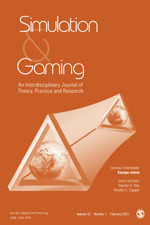
Simulation & Gaming
Multidisciplinary in Scope
The broad scope and interdisciplinary nature of Simulation & Gaming are demonstrated by the wide variety of interests and disciplines of its readers and contributors, who practice in areas such as: business, cognition, communication, decision making, economics, education, educational technologies, engineering, entrepreneurship, environmental issues, human resources, international studies, language training, learning theory, management, marketing, medicine, multiculturalism, negotiation, organization studies, peace and conflict studies, policy and planning, political science, project management, psychology, research methodology, sociology, teamwork, and technology.
Special Theme Issues & Debates
Simulation & Gaming frequently publishes single-theme Symposium Issues and Special Sections guest-edited by experts in the field.
Distinguished Sponsors
International Simulation and Gaming Association
North American Simulation and Gaming Association
Rigorous Peer Review
This journal is a member of the Committee on Publication Ethics (COPE).
Submit your manuscript today at https://mc.manuscriptcentral.com/sg.
For more than five decades, Simulation & Gaming has served as a leading international forum for the study and discussion of simulation/gaming methodologies used in education, training, healthcare, consultation, and research. This outstanding quarterly journal not only examines these methodologies, but also explores their application to real-world problems and situations. Simulation & Gaming: An Interdisciplinary Journal of Theory, Practice and Research contains articles examining academic and applied issues in the expanding fields of simulation, computerized simulation, gaming, modeling, play, roleplay, debriefing, game design, experiential learning, and related methodologies. The broad scope and interdisciplinary nature of Simulation & Gaming are demonstrated by the wide variety of interests and disciplines of its readers, contributors, and editorial board members. Areas include: healthcare, sociology, decision making, psychology, language training, cognition, learning theory, management, educational technologies, negotiation, peace and conflict studies, economics, international studies, communication, policy and planning, organization studies, political science, education, environmental issues, multiculturalism, and research methodology.
| Toshiko Kikkawa, Ph.D. | Keio University, Japan |
| Marlies P. Schijven, MD, Ph.D., MHSc | University of Amsterdam, The Netherlands |
| Mindi Anderson, Ph.D., APRN, CPNP-PC, CNE, CHSE-A, ANEF, FAAN | University of Central Florida, USA |
| Maria Laura Angelini Doffo, Ph.D. | Catholic University of Valencia, Spain |
| Sylvester Arnab, Ph.D. | Coventry University, UK |
| Olivier Barreteau, Ph.D., HDR | National Research Institute for Agriculture, Food and the Environment, France |
| Geertje Bekebrede, Dr.ir. | TU Delft, The Netherlands |
| Femke Bekius, Ph.D. | Radboud University, The Netherlands |
| Guido Borghi, Ph.D. | University of Modena and Reggio Emilia, Italy |
| Kristen M. Brown, DNP, CRNP, CPNP-AC, CHSE-A, FSSH, FAAN | Johns Hopkins University, USA |
| Marieke de Wijse-van Heeswijk, MSc, PhD researcher | Radboud University, The Netherlands |
| Hafize Demirci, MD | University Medical Centers of Amsterdam, The Netherlands |
| Desiree A. Díaz, Ph.D., APRN, FNP-BC, CNE, CHSE-A, ANEF, FSSH, FAAN | University of Central Florida, USA |
| Vinod Dumblekar, MBA, Ph.D. | MANTIS, New Delhi, India |
| Esther Edo Agustín, Ph.D. | University of Zaragoza, Spain |
| James Fielder, Ph.D. | Colorado State University, USA |
| Matthew Fish, Ph.D., LRT, CTRS, LPCA, BCB | East Carolina University, United States |
| Maria Freese, Ph.D. | Otto von Guericke University Magdeburg, Germany |
| Andreas Gerber, Ph.D. | Bern University of Applied Sciences, Switzerland |
| Mátyás Hartyándi, Ph.D. candidate | Corvinus University of Budapest, Hungary |
| Ronen Kasperski, Ph.D. | Gordon and Shaanan Academic Colleges of Education, Israel |
| Willy C. Kriz, Ph.D., MSc | University of Applied Sciences, Voralberg, Austria |
| Christophe Le Page, Ph.D., HDR | French Agricultural Research Centre for International Development (CIRAD), France |
| Elyssebeth Leigh, EdD | ISAGA, Australia |
| James Leung, MD, FRCPC | McMaster University / McMaster Children's Hospital, Canada |
| Orna Levin, Ph.D | Achva Academic College, Israel |
| Elena Y. Likhacheva, Ph.D. | Lomonosov Moscow State University, Russia |
| Heide Lukosch, Dr. rer. soc. | University of Canterbury, New Zealand |
| Egemen Manci, Ph.D. | Izmir Democracy University, Turkey |
| Duccio Martelli, Ph.D. | University of Perugia, Italy |
| Igor Mayer, Ph.D. | Breda University of Applied Sciences, Netherlands |
| Sebastiaan Meijer, Ph.D. | KTH Royal Institute of Technology, Sweden |
| Yulia Muchnik-Rozanov, Ph.D. | Achva Academic College, Israel |
| Kapil Rajwani, M.D. | Weill Cornell Medical College, USA |
| Agnessa Spanellis, Ph.D. | University of Edinburgh, UK |
| Junkichi Sugiura, Ph.D. | Keio University, Japan |
| Kengo Suzuki, ME, Ph.D. | University of Tsukuba, Japan |
| Yusuke Toyoda, MA, Ph.D. | Ritsumeikan University, Japan |
| Friedrich Trautwein, Ph.D. | Baden-Württemberg Cooperative State University (DHBW), Germany |
| Marcin Wardaszko, Ph.D. | Kozminski University, Poland |
| Elizabeth Wells-Beede, Ph.D., RN, C-EFM, CHSE-A, CNE, ACUE, FAAN, FSSH | The University of North Texas Health Sciences College of Nursing at Fort Worth, USA |
| Cevin Zhang, Ph.D | Beijing Technology and Business University, China |
Manuscript submission guidelines can be accessed on Sage Journals.